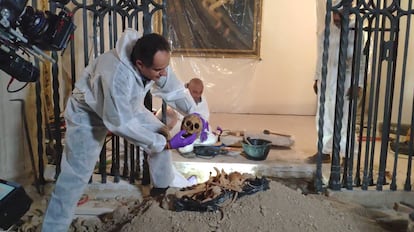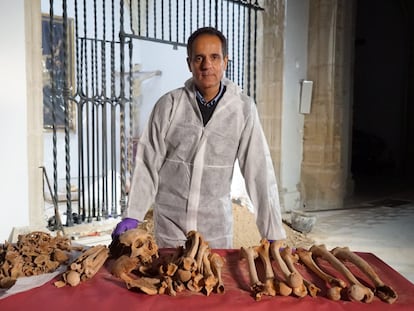International experts slam alleged Columbus DNA findings: ‘Commenting on this is like commenting on aliens’
World leaders in this field condemn the way in which the data on the supposed origins of the explorer has been released and question its validity

Some of the world’s leading DNA researchers are shocked by how the results of the analysis of the alleged remains of Christopher Columbus have been presented. José Antonio Lorente — a forensic scientist from the University of Granada in Spain, who was responsible for this research — claimed that Columbus was likely a Sephardic Jew who lived on Spain’s Mediterranean coast. This claim challenges the dominant historical view, which holds that Columbus was Genoese. Lorente’s hypothesis is reportedly based on a partial DNA analysis of the supposed remains of Columbus and his son, Hernando.
What has alarmed scientists is that these claims were released through a “film,” as Lorente himself described the documentary Columbus DNA: His True Origins, co-produced by the Spain’s state-owned broadcaster TVE, which attracted a record audience of over two million viewers when it aired on October 12. Yet no independent expert opinions or solid, peer-reviewed facts were presented.
The story about Columbus’ DNA has spread worldwide, receiving coverage from prestigious media outlets, yet not a single critical voice or independent opinion has been included. According to sources consulted for this report, the actions of José Antonio Lorente — who has controlled the study of the alleged remains of Columbus for over 20 years — along with TVE, represent an attack on the scientific method. This method typically requires new findings to be shared in a way that allows other researchers to review and verify the results or identify any potential errors.
It seems easy to use the power of DNA to claim that Columbus was a Sephardic Jew born on the Iberian Peninsula, but all the experts who spoke to EL PAÍS argue it is impossible to reach such a conclusion. Researchers caution that such an unsubstantiated announcement tarnishes the reputation of the broader scientific community. Since the documentary aired, Lorente has stated that he will not answer questions until he gives a press conference in November, when he plans to present the results. He has promised that the findings will be published in an international scientific journal, so that they are accessible to all researchers and experts. However, as of now, no one has seen the data.
David Reich, a renowned researcher at Harvard University and one of the world’s foremost experts in ancient DNA, finds himself in a difficult position regarding this controversy. “We need the data to be available, otherwise it is impossible to know if the conclusions are correct,” he explains. “It is not a trivial task to confirm that someone is connected to a specific group [such as Sephardic Jews]. Based on the type of analysis described, there doesn’t seem to be any solid foundation for claiming a connection with medieval Spanish Jews. Before we can take such a claim seriously, all the evidence and data must be published.”
Reich, who is himself a descendant of Jews who fled Europe during the Holocaust, also emphasizes the importance of independent verification: “It would be preferable for an independent laboratory, one that isn’t tied to a television documentary, to analyze the DNA and confirm the results.”
In 2003, the box containing the supposed remains of Christopher Columbus, buried in Seville Cathedral since the late 19th century, was opened. Inside was a mix of broken bones — about 150 grams — along with dirt and dust. Columbus’ remains had previously been interred in Valladolid, Santo Domingo, and Havana before being moved to Seville. Lorente has admitted that the small amount of DNA he claims to have extracted is “very degraded.”
Forensic scientists working with such remains typically rely on two types of genetic evidence. The most reliable is nuclear DNA, which contains the majority of a person’s genome and can provide detailed information about their ancestry. However, in this case, only mitochondrial DNA (passed down the matrilineal line) and Y-chromosome DNA (passed down the patrilineal line) have been recovered. Lorente has not clarified how much DNA he was able to extract, but he claims that the DNA from the supposed remains of Columbus’ son, Hernando, indicates Jewish ancestry and origins on the Mediterranean coast of the Iberian Peninsula.
One of the most outspoken critics is Johannes Krause, director of the Max Planck Institute for Evolutionary Anthropology. “I am not going to comment on any research presented in a TV documentary. If I did, I would also have to comment on aliens, the flat Earth theory, Atlantis, and other pseudoscience,” he says.
Geneticist Iñigo Olalde, a collaborator of David Reich and an expert in ancient DNA at the University of the Basque Country, also points out the frailty of the evidence, despite Lorente’s 20-year effort to extract DNA from the remains of Columbus and his relatives. “From a technical perspective, it would not have been impossible to sequence the entire genome,” Olalde says. “Those in charge of this research should have involved experts in ancient DNA, who routinely extract highly complete genomes from samples that are thousands of years old. Yet they haven’t even attempted to use the latest sequencing technologies.”
Olalde also highlights the limitations of the data presented: “Relying on the Y chromosome and mitochondrial DNA provides only a very partial picture of someone’s ancestry. Furthermore,” he warns, “after numerous failed attempts, they have likely already wasted many bone samples.”
Biologist Juan Carlos Martínez-Cruzado, who has spent years analyzing the DNA of Latin American populations to reconstruct the history of their Indigenous peoples before the Spanish conquest, also weighs in on the controversy. “At this point, there isn’t enough knowledge about Sephardic haplotypes to definitively conclude that an individual’s remains are of Sephardic origin,” he explains. Martínez-Cruzado notes that mitochondrial DNA could potentially offer more definitive results — if it were true that, during Columbus’ time, there was minimal interbreeding between Sephardic Jews and Iberians. However, he adds, “What has been published so far is consistent with being the same as his brother’s DNA — except now it turns out that they may not have been brothers, but rather second or third cousins.”
Martínez-Cruzado raises concerns about earlier findings: “Remember, this result was used to affirm that these remains were indeed those of Christopher Columbus. Now, doubts resurface about whether these remains truly belong to the great admiral.” He stresses that “all of this will remain speculative until the data is published and peer-reviewed.”
Despite the lack of concrete evidence, Martínez-Cruzado argues: “It will be very difficult to dispel the belief that Columbus was a Sephardic Jew born in Spain, even if this conclusion is eventually proven false. The world tends to assume that if a conclusion is based on DNA studies, it must be true. There is a dangerously blind faith in DNA studies.”
Rasmus Nielsen, a professor at the University of California, Berkeley, highlights another significant issue: “This analysis falls into the trap of genetic essentialism by equating nationalities with genetic groups. Ethnicities are actually far more complex, and there is no total correspondence between a person’s DNA and their ethnicity,” he explains.
Harald Ringbauer, head of archaeogenetics at the Max Planck Institute for Evolutionary Anthropology, shares concerns about the impact on the scientific community. “Revealing results to the media without undergoing peer review casts doubt on the credibility of the entire field,” he says. Ringbauer warns that Lorente’s team may have only been able to extract very small or even contaminated DNA fragments from the remains, a common risk in studies of this nature. “Spain has exceptional scientists in this area, and it would be a shame to cast doubt on their work with these sensationalist announcements,” he adds.
Taras Oleksyk, a geneticist at Oakland University and a collaborator on the Genome Europe project, is equally direct in his criticism. For scientists, he says, Lorente’s claims are “illegitimate” because they fail to meet even the most basic scientific standards. “Extraordinary claims about a figure as significant as Columbus must adhere to the highest quality standards and be peer-reviewed, which is like the court system in the scientific world,” Oleksyk explains. He adds: “When scientists announce results without undergoing this scrutiny, it sets off all the alarm bells.”
Sign up for our weekly newsletter to get more English-language news coverage from EL PAÍS USA Edition
Tu suscripción se está usando en otro dispositivo
¿Quieres añadir otro usuario a tu suscripción?
Si continúas leyendo en este dispositivo, no se podrá leer en el otro.
FlechaTu suscripción se está usando en otro dispositivo y solo puedes acceder a EL PAÍS desde un dispositivo a la vez.
Si quieres compartir tu cuenta, cambia tu suscripción a la modalidad Premium, así podrás añadir otro usuario. Cada uno accederá con su propia cuenta de email, lo que os permitirá personalizar vuestra experiencia en EL PAÍS.
¿Tienes una suscripción de empresa? Accede aquí para contratar más cuentas.
En el caso de no saber quién está usando tu cuenta, te recomendamos cambiar tu contraseña aquí.
Si decides continuar compartiendo tu cuenta, este mensaje se mostrará en tu dispositivo y en el de la otra persona que está usando tu cuenta de forma indefinida, afectando a tu experiencia de lectura. Puedes consultar aquí los términos y condiciones de la suscripción digital.
More information
Archived In
Últimas noticias
Most viewed
- Christian Louboutin: ‘Young people don’t want to be like their parents. And if their parents wear sneakers, they’re going to look for something else’
- ‘El Limones’ and the growing union disguise of Mexican organized crime
- Cartels in Mexico take a leap forward with narco-drones: ‘It is criminal groups that are leading the innovation race’
- The low-cost creative revolution: How technology is making art accessible to everyone
- ‘We are dying’: Cuba sinks into a health crisis amid medicine shortages and misdiagnosis











































